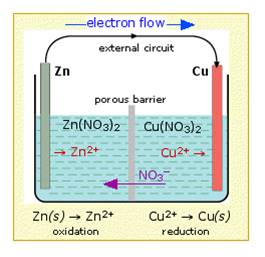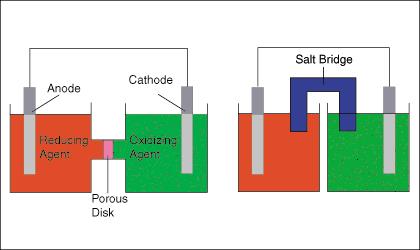Galvanic Cells
Currently, it is not possible the potential difference between a strip of metal and a solution where the metal is dipped in. This arrangement is known as a galvanic cell and the situation can be represented as an oxidation-reduction (redox) reaction equation. A typical call consists of two strips of metal (one zinc and the other copper) and they are usually dipped in a solution containing salt from the corresponding metal. The two sides are separated by a porous barriers; this is because it avoids the two mixers from mixing at a fast rate but still allows the ions to diffuse from both sides. The set up can be seen in the picture.
The Main Idea
Oxidation – reduction reactions are very useful when it comes to calculating electrical energy in batteries. A basic electrochemical cell can be made with copper and zinc metals and solutions of their sulfates. During this reaction, the electrons from the zinc will be transferred to the copper through an electric conducting path (electric current). The more basic version of a galvanic cell is called an electrochemical cell; the difference is that galvanic cells can generate electric current.
Half cell reaction in its simplest form consists of an electrode (solid metal) which is immersed in a solution that has cations from the metal and anions to neutralize the charges. A galvanic cell has two-half cells; where one of the half cells is composed of metal A and the electrode of the other half-cell is composed of metal B; the equation would be:
A^n+ + ne- --> A
B^m+ + me- --> B
The two electrodes are connected with a metal wire which conduct the electrons that participate. The electrode are connected with a metal wire in order to allow the electrons to transfer and participate in the reaction.
History
Scientist, Luigi Galvani discovered that two different metals , copper and zinc, when connected to a frog leg’s nerve made the nerve twitch. After this discovery, Alessandro Volta invented the voltaic pile which consisted a very similar set up to the galvanic cells. Carlo Matteucci constructed a battery entirely out of biological matter and all these discoveries added up to the invention of the electrical battery in 1999.
Examples
Further reading
Books, Articles or other print media on this topic
External links
http://www.chem1.com/acad/webtext/elchem/ec2.html
References
http://www.sparknotes.com/chemistry/electrochemistry/galvanic/section2/page/2/

